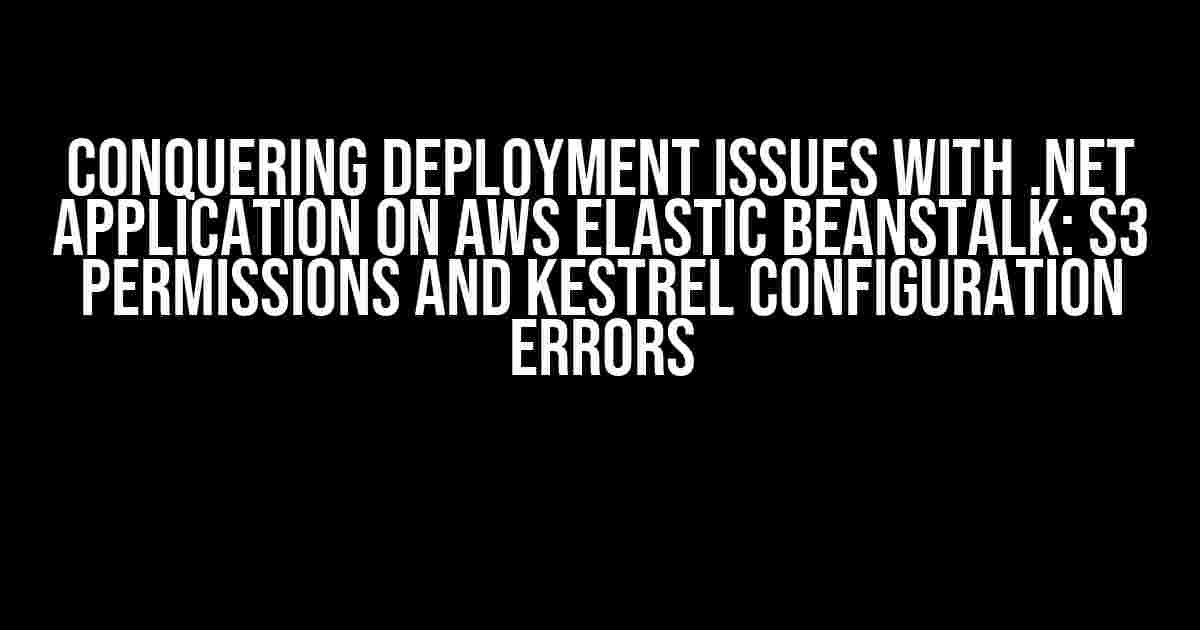Are you tired of wrestling with deployment issues on AWS Elastic Beanstalk? Do S3 permissions and Kestrel configuration errors have you pulling your hair out? Fear not, brave developer! This comprehensive guide will walk you through the most common pitfalls and provide clear, step-by-step solutions to get your .NET application up and running smoothly on AWS Elastic Beanstalk.
Understanding the Beast: AWS Elastic Beanstalk and .NET Applications
AWS Elastic Beanstalk is a powerful platform for deploying web applications and services. When it comes to .NET applications, however, things can get a bit more complicated. The good news is that AWS provides excellent support for .NET applications, and with the right configuration, you can enjoy a seamless deployment experience.
The Role of S3 Permissions in Deployment
S3 (Simple Storage Service) is Amazon’s cloud-based object storage system. In the context of Elastic Beanstalk, S3 plays a crucial role in storing and serving application artifacts, such as binaries, configuration files, and logs. However, improper S3 permissions can lead to deployment issues, including:
- Failed deployments due to insufficient access to S3 buckets
- Inability to upload application artifacts to S3
- Logs and configuration files not being updated correctly
To avoid these issues, you need to ensure that your Elastic Beanstalk environment has the necessary S3 permissions. Here’s how:
Step 1: Create an IAM Role for Elastic Beanstalk
Create an IAM role with the necessary permissions for Elastic Beanstalk to access S3. You can do this by following these steps:
aws iam create-role --role-name my-elastic-beanstalk-role --assume-role-policy-document file://trust-policy.json
trust-policy.json:
{
"Version": "2012-10-17",
"Statement": [
{
"Sid": "",
"Effect": "Allow",
"Principal": {
"Service": "elasticbeanstalk.amazonaws.com"
},
"Action": "sts:AssumeRole"
}
]
}
Step 2: Attach the IAM Role to Elastic Beanstalk
Attach the IAM role to your Elastic Beanstalk environment:
aws elasticbeanstalk update-environment --environment-name my-environment --solution-stack-name "64bit Windows Server 2019 v2.11.14 running IIS 10.0" --option-settings file://option-settings.json
option-settings.json:
[
{
"Namespace": "aws:elasticbeanstalk:environment",
"OptionName": "ServiceRole",
"Value": "my-elastic-beanstalk-role"
}
]
Taming the Kestrel Configuration Beast
Kestrel is a lightweight, open-source web server for .NET Core applications. While it’s an excellent choice for hosting .NET applications, improper configuration can lead to deployment issues, including:
- Failed deployments due to incorrect Kestrel configuration
- Inability to bind to the correct port
- Issues with SSL/TLS certificates
To avoid these issues, you need to ensure that your Kestrel configuration is correct. Here’s how:
Step 1: Configure Kestrel in Your .NET Application
In your .NET application, configure Kestrel to use the correct port and SSL/TLS certificates. You can do this by adding the following code to your Startup.cs file:
public void Configure(IApplicationBuilder app, IWebHostEnvironment env)
{
// ...
app.UseKestrel(options =>
{
options.Listen(IPAddress.Loopback, 5000);
options.Listen(IPAddress.Loopback, 5001, listenOptions =>
{
listenOptions.UseHttps("path/to/ssl/certificate.pfx", "password");
});
});
// ...
}
Step 2: Update the Elastic Beanstalk Environment
Update your Elastic Beanstalk environment to use the correct Kestrel configuration:
aws elasticbeanstalk update-environment --environment-name my-environment --option-settings file://option-settings.json
option-settings.json:
[
{
"Namespace": "aws:elasticbeanstalk:container:dotnet:environment",
"OptionName": "kehstrel_port",
"Value": "5000"
},
{
"Namespace": "aws:elasticbeanstalk:container:dotnet:environment",
"OptionName": "kehstrel_ssl_port",
"Value": "5001"
}
]
| Option | Description |
|---|---|
| kehstrel_port | The port number that Kestrel listens on |
| kehstrel_ssl_port | The SSL/TLS port number that Kestrel listens on |
Troubleshooting Common Deployment Issues
Even with the correct S3 permissions and Kestrel configuration, deployment issues can still occur. Here are some common issues and their solutions:
Issue 1: Failed Deployment Due to Insufficient S3 Permissions
Solution:
- Verify that the IAM role has the necessary S3 permissions
- Check the S3 bucket policy to ensure that it allows access from the Elastic Beanstalk environment
- Update the IAM role or S3 bucket policy as necessary
Issue 2: Kestrel Configuration Errors
Solution:
- Verify that the Kestrel configuration is correct in the .NET application
- Check the Elastic Beanstalk environment configuration to ensure that it matches the Kestrel configuration
- Update the Kestrel configuration or Elastic Beanstalk environment as necessary
Issue 3: SSL/TLS Certificate Issues
Solution:
- Verify that the SSL/TLS certificate is correctly configured in the .NET application
- Check that the SSL/TLS certificate is correctly uploaded to the S3 bucket
- Update the SSL/TLS certificate configuration or upload a new certificate as necessary
Conclusion
Deploying a .NET application on AWS Elastic Beanstalk can be a complex process, but with the right configuration and troubleshooting techniques, you can overcome common deployment issues. By following the steps outlined in this guide, you’ll be well on your way to deploying your .NET application smoothly and efficiently. Remember to stay vigilant, monitor your logs, and troubleshoot issues as they arise. Happy deploying!
Keywords: AWS Elastic Beanstalk, .NET application, S3 permissions, Kestrel configuration, deployment issues, troubleshooting, SSL/TLS certificates, IAM role, S3 bucket policy, Kestrel port, Kestrel SSL port.
Frequently Asked Questions
Stuck with deployment issues of your .NET application on AWS Elastic Beanstalk? Worry not! We’ve got you covered. Here are some common questions and answers to help you troubleshoot those pesky S3 permissions and Kestrel configuration errors.
Q1: Why is my .NET application failing to deploy on AWS Elastic Beanstalk with S3 permissions error?
A1: This is likely due to incorrect or missing permissions for the IAM role used by Elastic Beanstalk. Ensure that the IAM role has the necessary permissions to access the S3 bucket, such as `s3:GetObject`, `s3:PutObject`, and `s3:ListBucket`. You can check the IAM role’s permissions in the AWS Management Console or using the AWS CLI.
Q2: How do I configure Kestrel server options for my .NET application on Elastic Beanstalk?
A2: To configure Kestrel server options, you can add a `kestrel` section to your `appsettings.json` file. For example, you can set the `Listen` option to configure the IP address and port: `{ “Kestrel”: { “Listen”: { “Any”: { “Address”: “0.0.0.0”, “Port”: 5000 } } } }`. You can also configure other options, such as `UseHttps` or `UseIISIntegration`.
Q3: What are the common Kestrel error messages I should look out for during deployment on Elastic Beanstalk?
A3: Common Kestrel error messages include `Failed to bind to address …`, `Failed to start Kestrel`, or `Address already in use`. These errors can be caused by incorrect configuration, port conflicts, or permission issues. Check your `appsettings.json` file and Kestrel configuration to ensure that they are correct and valid.
Q4: How do I troubleshoot S3 permission issues for my .NET application on Elastic Beanstalk?
A4: To troubleshoot S3 permission issues, check the Elastic Beanstalk environment’s logs for error messages related to S3 access. You can also use the AWS CLI to verify the IAM role’s permissions and test S3 access. Additionally, ensure that the IAM role is correctly configured and assigned to the Elastic Beanstalk environment.
Q5: Can I use a single IAM role for multiple Elastic Beanstalk environments with different S3 buckets?
A5: While it’s technically possible to use a single IAM role for multiple Elastic Beanstalk environments, it’s not recommended. Each environment should have its own IAM role with the necessary permissions tailored to that environment’s specific needs. This helps maintain security and avoids permission conflicts between environments.



